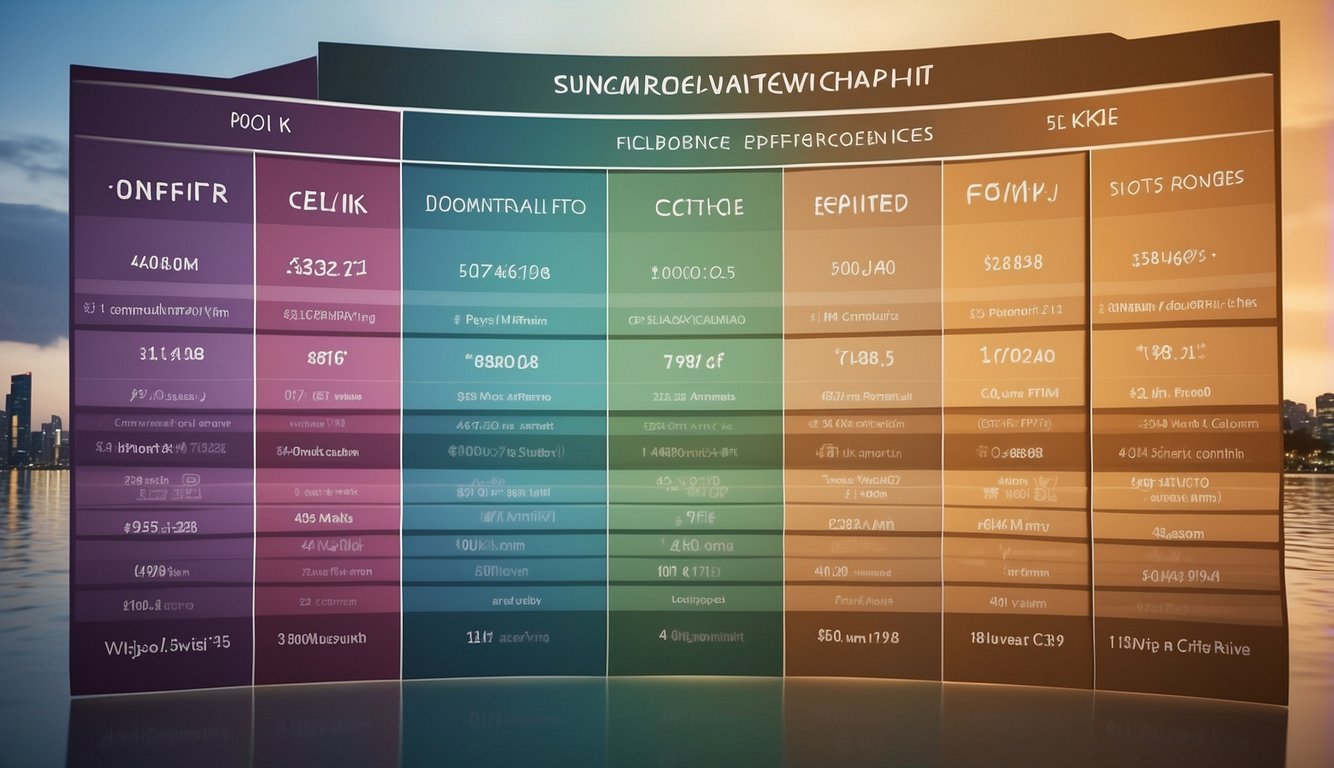
Are you considering retirement savings plans? If so, you may have come across the 401(K) vs. CPF in Singapore.
While both schemes aim to help individuals save for retirement, they are not the same. In this article, we will provide you with a comprehensive comparison of CPF and 401(k) plans to help you understand the differences and equivalents between them.
Understanding retirement systems is essential when it comes to planning for your future. CPF is a mandatory provident fund in Singapore that caters to other purposes such as healthcare, education, and housing.
On the other hand, 401(k)s are voluntary for US citizens and are designed to help individuals save for retirement. Both systems have unique features, and it’s essential to understand them to make an informed decision.
Contributions and savings accumulation, investment options and risks, taxation and incentives, withdrawals and payouts, comparative analysis, additional benefits and features.
Moreover, the future of retirement is one of the factors you need to consider when choosing a retirement savings plan. In this article, we will explore these factors in detail and provide you with a comprehensive comparison of CPF and 401(k) plans.
401(K) vs. CPF in Singapore: Understanding Retirement Systems

Basics of the 401(K) Plan
When it comes to retirement planning, the 401(k) plan is a popular choice in the United States. It is an employer-sponsored retirement savings account that allows you to save and invest a portion of your paycheck before taxes are taken out. This means you can potentially grow your retirement savings more quickly. Contributions to a 401(k) are automatically deducted from your paycheck, making it a convenient way to save for retirement.
Overview of the Central Provident Fund (CPF)
In Singapore, the Central Provident Fund (CPF) is a compulsory, government-sponsored retirement savings scheme. It serves as a social security system, helping Singaporeans set aside funds for retirement, healthcare, and housing needs. Contributions to CPF are made by both employees and employers, and the funds are invested in a range of approved instruments to generate returns.
Retirement Planning Principles
When considering retirement planning, it’s essential to understand the principles of both the 401(k) and CPF systems. Both aim to provide financial security in retirement, but they have distinct features and benefits. Understanding the differences and equivalents between these two systems can help you make informed decisions about your retirement savings and income.
401(K) vs. CPF in Singapore: Contributions and Savings Accumulation

When it comes to retirement savings plans, contributions are a crucial aspect to consider. Both the 401(K) and CPF have their own unique contribution systems.
Contributions to 401(K) and CPF
In the United States, contributions to the 401(K) plan are usually voluntary, with the option to contribute up to a maximum of USD 22,500 for 2023. On the other hand, the CPF contribution system in Singapore is mandatory for both employers and employees. As of 2023, the employee contribution rate is 20% of their monthly salary, while the employer contribution rate is 17% of the employee’s monthly salary.
Interest Rates and Growth
Another factor to consider is the interest rates and growth of savings for both plans. The 401(K) plan in the United States typically has a fixed interest rate, which varies depending on the investment portfolio. In contrast, the CPF in Singapore has a tiered interest rate system, where the first SGD 60,000 earns an extra 1% interest per annum, and the next SGD 30,000 earns an additional 1.5% interest per annum.
Additionally, the CPF also offers a Retirement Sum Scheme (RSS) that guarantees a fixed monthly payout for life upon retirement. The RSS is designed to provide a steady stream of income in retirement, ensuring that you have a stable source of income throughout your golden years.
Overall, both the 401(K) and CPF have their own unique contribution and savings accumulation systems. It’s important to consider your individual needs and financial goals when choosing which plan is right for you.
401(K) vs. CPF in Singapore: Investment Options and Risks

When it comes to investment options and risks, both 401(K) and CPF offer different schemes. Here’s a breakdown of the investment options and risks for both:
401(K) Investment Choices
With 401(K), you have the option to choose from a range of financial instruments such as stocks, bonds, and mutual funds. This flexibility allows you to tailor your investment choices to your risk tolerance and investment goals. However, it’s important to note that investing in stocks and mutual funds comes with a higher level of risk.
CPF Investment Schemes
CPF offers four different accounts: the Ordinary Account (OA), Special Account (SA), Medisave Account (MA), and Retirement Account (RA). Each account serves a different purpose, with the SA being primarily for retirement and the MA for medical expenses. CPF also offers a range of investment schemes, such as the CPF Investment Scheme (CPFIS) and the CPF Retirement Sum Scheme (RSS). These schemes allow you to invest your CPF savings in various financial instruments such as bonds and unit trusts.
Assessing Investment Risk
When it comes to assessing investment risk, it’s important to consider your risk tolerance and investment goals. Both 401(K) and CPF offer different investment options with varying levels of risk. It’s crucial to understand the risks associated with each investment option and choose one that aligns with your investment goals and risk tolerance. It’s also important to diversify your investments to minimize risk.
Overall, both 401(K) and CPF offer different investment options and risks. It’s important to understand the differences between the two and choose one that best suits your investment goals and risk tolerance.
401(K) vs. CPF in Singapore: Taxation and Incentives

When it comes to retirement savings, tax benefits are a crucial consideration. Both 401(K) and CPF offer tax advantages that can help you save money in the long run. In this section, we’ll explore the tax benefits of both plans.
Tax Benefits of 401(K)
One of the primary tax benefits of a 401(K) plan is that contributions are tax-deductible. This means that the money you contribute to your project is deducted from your taxable income. For example, if you earn £40,000 per year and contribute £5,000 to your 401(K), your taxable income will be reduced to £35,000. This can result in significant tax savings over time.
Another tax advantage of a 401(K) plan is that your contributions grow tax-free until you withdraw them. This means that you don’t have to pay taxes on the money you earn through investment gains or interest until you take the money out of your account.
Tax Advantages in CPF
CPF also offers tax-deductible contributions, which can help you save money on taxes. However, the tax relief is capped at a certain amount. For example, in 2023, the maximum amount of tax relief for CPF contributions is £7,000 per year.
CPF also offers tax-advantaged growth. Like a 401(K) plan, your CPF contributions grow tax-free until you withdraw them. Additionally, when you reach retirement age, the money you exit from your CPF account is tax-free.
In summary, both 401(K) and CPF offer tax benefits that can help you save money on taxes and grow your retirement savings. However, the specific tax advantages and limitations of each plan may vary. It’s essential to do your research and consult with a financial advisor to determine which plan is best for you.
401(K) vs. CPF in Singapore: Withdrawals and Payouts

401(K) Withdrawal Rules
When it comes to 401(K) withdrawals, you have the flexibility to start withdrawing funds penalty-free after the age of 59 and a half. However, if you decide to make withdrawals before this age, you may incur a 10% early withdrawal penalty. It’s important to note that the leaves are subject to income tax, and you can choose to take a lump sum or opt for periodic payments.
CPF Withdrawals and Payouts
In contrast, the Central Provident Fund (CPF) in Singapore offers a different approach. Upon reaching the age of 55, you can make a lump sum withdrawal of your CPF savings, subject to certain limits. Additionally, you can also choose to receive monthly payouts from your CPF savings to support your retirement years. These payouts are designed to provide a steady stream of income during your retirement, offering financial security and peace of mind.
By understanding the withdrawal rules and payout options for both 401(K) and CPF, you can make informed decisions that align with your retirement goals and financial needs.
401(K) vs. CPF in Singapore: Comparative Analysis

Similarities and Differences
When it comes to retirement plans, both CPF and 401(k) plans serve the same purpose: to help you save for retirement. However, there are a few key differences between the two plans that you should be aware of.
One significant difference is the availability of the plans. CPF is only available to Singapore citizens and permanent residents, while 401(k) plans are only available to US citizens and permanent residents. Another difference is the terms of the projects. CPF has a mandatory contribution rate of 37% of an individual’s income, while 401(k) plans have a contribution limit of $19,500 per year.
Additionally, CPF life is a unique feature of the CPF plan that provides a lifelong monthly payout to retirees. The 401(k) plan does not have a similar part, but it does offer the option to withdraw funds as a lump sum or in periodic payments.
Pros and Cons
Both CPF and 401(k) plans have their pros and cons. Here are a few to consider:
CPF Plan
- Pros:
- Mandatory contributions ensure that you save for retirement
- CPF life provides a lifelong monthly payout to retirees
- Can be used for other purposes such as housing, healthcare, and insurance
- Cons:
- Limited investment options
- Mandatory contributions may limit your disposable income
- Only available to Singapore citizens and permanent residents
401(k) Plan
- Pros:
- Contribution limits are higher than CPF
- Offers a wide range of investment options
- It can be rolled over into an IRA or another employer’s plan.
- Cons:
- No lifelong monthly payout option
- Limited availability to US citizens and permanent residents
- Investment fees can be high
401(K) vs. CPF in Singapore: Additional Benefits and Features

Healthcare and Insurance
One of the most significant benefits of the CPF system is the provision of healthcare and insurance. Your MediSave account can be used to pay for medical expenses, including hospitalization and outpatient treatments. You can also use MediShield Life, a basic health insurance plan that covers large hospital bills and selected outpatient treatments.
Homeownership Options
The CPF system also provides homeownership options. You can use your CPF savings to pay for your HDB flat or private property. Your Ordinary Account can be used to pay for the downpayment and monthly mortgage payments. You can also use your CPF savings to pay for upgrading your HDB flat and to purchase private properties overseas.
Schemes for Low Incomes
The CPF system offers several schemes to help low-income earners save for their financial future. The Workfare Income Supplement (WIS) is a cash supplement that provides additional income to low-wage workers. The CPF Matched Retirement Savings Scheme (MRSS) matches the contributions made by low-income earners to their Retirement Account (RA). The scheme aims to encourage low-income earners to save for their retirement.
Overall, the CPF system provides a comprehensive set of benefits and features to help Singaporeans save for their financial future. From healthcare and insurance to homeownership options and schemes for low incomes, the CPF system is designed to provide a safety net for Singaporeans.
401(K) vs. CPF in Singapore: The Future of Retirement

Emerging Trends in Retirement Savings
Retirement planning is essential for securing your financial future. With the increasing life expectancy and the potential impact of inflation, it’s crucial to consider long-term financial strategies. In Singapore, the Supplementary Retirement Scheme (SRS) provides an avenue for individuals to augment their retirement savings while enjoying tax benefits.
Adapting to Changing Economic Conditions
As economic conditions evolve, it’s essential to adapt your retirement plans accordingly. Consider diversifying your retirement portfolio to mitigate risks and take advantage of emerging investment opportunities. Keep a keen eye on the changing economic landscape and be proactive in adjusting your retirement savings strategy to align with future financial goals.
Conclusion

Now that you have a better understanding of the differences and equivalents between 401(K) and CPF, you can make an informed decision about which retirement scheme is right for you.
While both schemes have their advantages and disadvantages, CPF offers a mandatory safety net for Singapore citizens and permanent residents, ensuring that everyone has some level of retirement savings. On the other hand, 401(K) offers more flexibility and control over your retirement savings, allowing you to invest in a broader range of assets.
Ultimately, the decision between 401(K) and CPF depends on your individual financial situation, goals and preferences. It is essential to consult with a financial advisor to determine the best retirement plan for you.
In Singapore, the CPF system is a comprehensive social security system that not only caters to retirement savings but also healthcare, education and housing. While regarded as generally successful, the CPF has been criticized recently for not achieving retirement adequacy.
On the other hand, 401(K) is a voluntary retirement plan for US citizens that is managed by employers. It is a tax-advantaged investment account that allows you to save for retirement. One key advantage of 401(K) is that you can contribute pre-tax dollars, which reduces your taxable income.
In conclusion, both 401(K) and CPF have their pros and cons, and it is up to you to decide which retirement scheme is best for your needs. It is essential to do your research, consult with a financial advisor, and make an informed decision about your retirement savings.
Frequently Asked Questions

How do the contribution rates between a 401(k) and Singapore’s CPF compare?
The contribution rates for a 401(k) and Singapore’s CPF differ significantly. For a 401(k), the contribution rate is determined by the employee, and the employer may choose to match a portion of that contribution.
However, for CPF, the contribution rate is determined by the employee’s age and income, and the employer is required to contribute a percentage of the employee’s pay to CPF.
What are the tax implications for 401(k) plans versus CPF contributions?
Contributions to a 401(k) are tax-deductible, which means you can reduce your taxable income by contributing to your 401(k). However, you will have to pay taxes on the contributions and any earnings when you withdraw the funds.
On the other hand, CPF contributions are not tax-deductible, but they are not taxed when they are removed.
Can you explain the retirement benefits differences between CPF and 401(k) schemes?
CPF and 401(k) schemes have different retirement benefits. CPF provides a monthly retirement income, healthcare benefits, and housing benefits, while 401(k) plans provide a lump sum payment that can be used for retirement expenses but do not provide healthcare benefits or housing benefits.
What are the options for early withdrawal from a 401(k) and CPF, and how do they differ?
401(k) plans allow for early withdrawals in certain circumstances, such as financial hardship or medical expenses, but there are penalties for early withdrawal. CPF also allows for early withdrawals for specific purposes, such as purchasing a home or paying for medical costs, but there are restrictions and penalties for early withdrawal.
In what ways does the investment flexibility of a 401(k) differ from that of the CPF?
401(k) plans offer more investment flexibility than CPF, as employees can choose from a variety of investment options, including stocks, bonds, and mutual funds. CPF investments are managed by the government, and the investment options are limited.
How does the government’s role in managing CPF funds contrast with the private management of 401(k) accounts?
The government manages CPF funds, and the investment options are limited to a few government-approved options. In contrast, 401(k) plans are governed by private financial institutions, and employees have more investment options to choose from.

